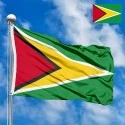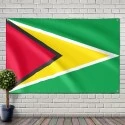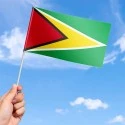The flag of Guyana, known as "The Golden Arrowhead," is a modern and dynamic national symbol that vividly reflects the nation's geography, wealth, and aspirations. Adopted in 1966 on the day the country gained its independence, it was designed by a renowned American vexillologist and has since served as a proud emblem of Guyana's sovereignty and unity.
A Detailed Look at the Flag's Design and Symbolism
The flag of Guyana features a green field with a large golden triangle, or arrowhead, bordered in white. This arrowhead points from the hoist side to the fly side, and inside it is a smaller red triangle, bordered in black. The design is a powerful visual representation of the nation's identity.
Each color and shape on the flag has a specific meaning:
-
Green: The green field represents the forests and agricultural lands of Guyana. It symbolizes the rich natural resources, biodiversity, and the country's vast flora, which form the basis of its economy and national identity. It is a tribute to the country's natural beauty and its commitment to sustainability.
-
White Border: The white border surrounding the golden arrowhead represents the rivers and water of Guyana. It symbolizes the country's extensive network of rivers and its water resources, which are crucial for life and trade. White also signifies purity and the dedication of the nation's people to their ideals.
-
Golden Arrowhead: The large golden triangle, or "arrowhead," represents the mineral wealth of Guyana. It symbolizes the country's rich deposits of bauxite, gold, and other precious minerals, which have long been a source of its economic strength. The arrowhead shape is a nod to the nation's indigenous heritage and its forward-looking progress.
-
Black Border: The black border around the red triangle symbolizes the endurance and resilience of the Guyanese people. It is a tribute to the struggles and hardships faced by the nation and its ability to overcome adversity. Black represents the strength of the people as they build their future.
-
Red Triangle: The red triangle at the center of the flag represents the zeal and dynamic nature of the nation-building process. It symbolizes the fervour and passion of the Guyanese people in their quest for a better and more prosperous future. Red stands for the sacrifice and dedication that are necessary to achieve national progress.
The History and Creation of the Flag
The history of the Guyanese flag is unique in that its design was the result of an international competition. In the lead-up to Guyana’s independence from the United Kingdom, the country’s government held a global contest to find a design for its new national flag.
The winning design was created by Dr. Whitney Smith, a prominent American vexillologist (a specialist in the study of flags). His design was a powerful geometric representation that encapsulated the country's key features. While Dr. Smith's original design did not include the black and white fimbriations (borders), the College of Arms in London added them to give the colors more visual separation. The final version was officially adopted on May 26, 1966, the very day that Guyana declared its independence, making the flag a direct and powerful symbol of the nation's birth.
The adoption of the "Golden Arrowhead" marked a new era for Guyana, signifying a break from its colonial past and the beginning of its journey as a sovereign nation. The flag was raised for the first time at the National Park in Georgetown, replacing the Union Jack, and has since been a source of great national pride.
Meaning and Significance for Residents
For the people of Guyana, the flag is a beloved symbol of their independence and identity. The name "Golden Arrowhead" itself is a source of national pride, as it links the flag to the country’s rich indigenous culture and its aspirations for a dynamic future. The green field is a constant reminder of the nation’s natural beauty and the importance of its forests and agriculture. The arrowhead, pointing forward, signifies progress and the national goal of moving toward a better tomorrow. The various colors and their borders tell a story of a people who are resilient, dedicated, and united in their pursuit of peace and prosperity. The flag is proudly displayed on public buildings and private homes, especially on national holidays like Independence Day and Republic Day (February 23rd), serving as a powerful and unifying symbol for a diverse population. It embodies the collective spirit of a nation that is building its future on the foundations of its natural wealth and the strength of its people.
Interesting Facts
-
The flag's designer, Dr. Whitney Smith, is considered one of the founders of modern vexillology. He also designed flags for other countries and was a leading authority on the subject.
-
The flag is commonly referred to by its nickname, "The Golden Arrowhead," a term that is widely understood and used throughout the country.
-
The black and white borders, known as fimbriations, were a modification to the original design by the College of Arms. Their addition was a vexillological best practice to ensure the colors were distinct and well-defined.
-
The geometric design of the flag is quite unique among national flags, which often feature horizontal or vertical stripes. The arrowhead shape and the use of two borders make it a visually striking and memorable symbol.
-
The flag's adoption on the very day of independence makes it a powerful and direct symbol of national sovereignty, a feature that many other national flags do not possess.
In the demonstration images, full-size flags are shown with proportions of 2:3, and hand-held flags with proportions of 1:2.






 Waving flag
Waving flag
 Sizes:
Sizes:
 Round flag
Round flag
 Sizes:
Sizes:
 Rectangular flag 2:3
Rectangular flag 2:3
 Sizes:
Sizes: